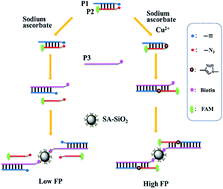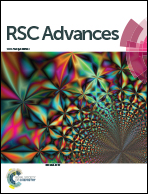A novel fluorescence polarization assay for copper ions based on DNA-templated click chemistry and amplification of nanoparticles†
Abstract
In this work, we developed a novel fluorescence polarization (FP) method for the sensitive detection of Cu2+ based on the chemical ligation of DNA by click chemistry and silica nanoparticles-assisted FP enhancement. A double-stranded DNA hybrid (P1P2) is used as an “end-of-helix” template with an alkyne group and an azide group at the end of two DNA strands, respectively. Cu2+ can be reduced to Cu+ by sodium ascorbate, and trigger the chemical ligation P1P2 through the Cu+-catalyzed azide–alkyne cycloaddition. A biotin-labeled P3 which can hybridize with P1 is introduced to displace the FAM-contained P2 from P1P2 duplex. Since P1 and P2 are linked after the Cu2+-triggered click chemistry, a P1P2P3 complex is formed which can be captured on the silica nanoparticle surface through the biotin-streptavidin interaction, thus achieving a high FP signal. In the absence of Cu2+, there is no ligation between P1 and P2. The released P2 is free and cannot be immobilized on the nanoparticle surface, resulting in a low FP. The specificity of click chemistry provides a high selectivity, and the nanoparticle-assisted FP enhancement provides a high sensitivity with a detection limit of 0.0178 μM. This method also displays good assay performance in real water samples, which may be further used for environmental monitoring.



 Please wait while we load your content...
Please wait while we load your content...